Video conf. notes 28 July 2016 - threat. sp supplementation
SWIFFT video conference notes are a summary of the video conference and not intended to be a definitive record of presentations made and issues discussed.
This video conference was supported through resources and technology provided by the Department of Environment, Land, Water and Planning, Victoria. SWIFFT wishes to thank speakers for their time and delivery of presentations. Thanks also to Glen Johnson (DELWP) who chaired the session from Wodonga.
The third video conference for 2016 had a theme on Threatened species population supplementation.
A total of 97 participants were connected across 16 locations; Ararat, Ballarat, Bendigo, Benalla, Colac, Geelong, Hamilton, Heywood, Horsham, Heidelberg (Arthur Rylah Institute), Knoxfield, Melbourne (Nicholson Street), Orbost, Warrnambool, Yarram and Wodonga.
List of groups/organisations in attendance;
Educational: Federation University, University of Melbourne.
Local Government: West Wimmera Shire, Yarra Ranges Shire, City of Hume.
Field Naturalist Clubs: Ballarat, Geelong, Hamilton, Portland.
Community Conservation Groups: VVP Biosphere, Kaniva District Landcare, Barenduna Landcare.
Conservation Organisations: Royal Botanic Gardens, Birdlfe Australia, Windamarra Aboriginal Corp., North Central CMA, Office of Environment & Heritage NSW, Local Land Services Albury, Cape Otway Conservation Ecology Centre, Parks Victoria, Department of Environment, Land, Water and Planning (DEWLP) staff across 16 locations, inc. Nicholson Street Melbourne, Knoxfield and Arthur Rylah Institute, Heidelberg.
KEY POINTS SUMMARY
Quick take home messages from this video conference or read through the speaker summaries.
SPEAKER SUMMARIES
Threatened frog supplementation
Regent Honeyeater supplementation
Threatened orchid supplementation
Mountain Pygmy-possum supplementation
Threatened frog supplementation - Dr David Hunter, NSW Office of Environment & Heritage (Albury)
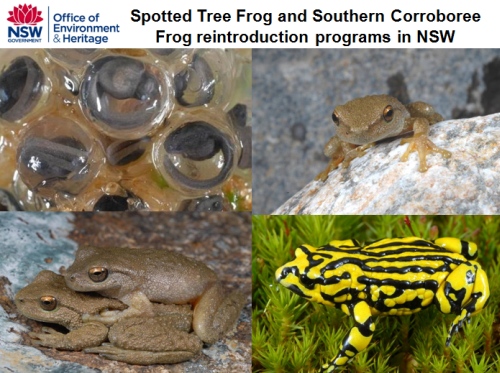
David spoke about the Spotted Tree Frog and Corroboree Frog as examples of threatened frog supplementation. He acknowledged the partnerships involved, in particular Taronga Zoo, Zoos Victoria and the Amphibian Research Centre which collectively manage the captive colonies that provide stock for reintroductions.
Role of Recovery Program
David said that without a captive breeding and reintroduction program the Southern Corroboree Frog and Spotted Tree Frog would be extinct in NSW. Captive breeding and reintroduction is crucial to the conservation of these species.
The main reason for decline in populations is infection by the Amphibian Chytrid Fungus (Batrachochytrium dendrobatidis) which is thought to have arrived in Australia in the early 1970's.
Southern Corroboree Frog
Broader Reintroduction Objectives:
- Prevent extinction of the Southern Corroboree Frog in the wild.
- Integrate management of captive and field colonies for the long-term management of the species genetic variation and field fitness.
Short-term Objectives:
- Develop efficient reintroduction techniques.
- Develop the capacity to maintain pathogen free colonies in field enclosures.
Project Duration:
- Indefinite (until such time as the Chytrid Fungus pathogen no longer poses a threat to self sustaining colonies).
Reintroduction methodology
One of the key goals in undertaking reintroductions is to reduce the level of impact of Chytrid Fungus pathogen by reducing contact between the Southern Corroboree Frog and the Common Eastern Froglet which is a key carrier of the pathogen in the environment where Southern Corroboree Frogs occur.
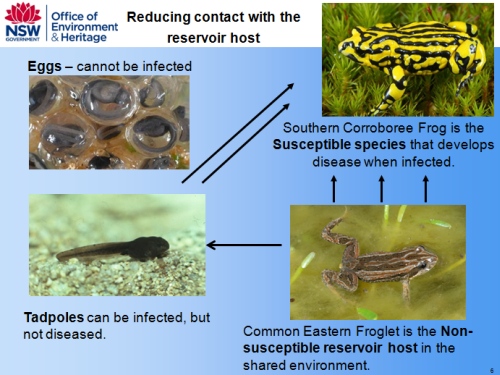
Management techniques to release Southern Corroboree Frog eggs whilst avoiding contact with the Common Eastern Froglet;
- Release of into artificial pools within the species former range.
- Release into artificial pools in areas not occupied by the Common Eastern Froglet.
- Release eggs and frogs into pathogen free field enclosures.
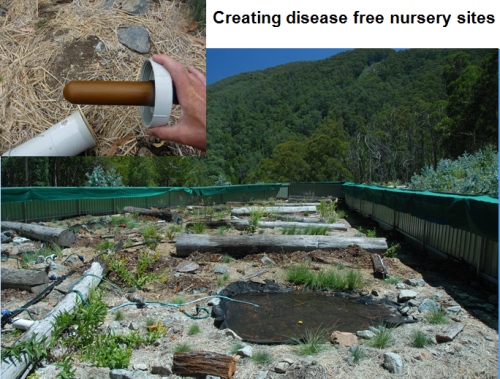
David said they have been able to demonstrate some limited level of success in maintaining populations in the wild through the release of captive bred eggs into artificial pools in areas where the species once occurred. The program has effectively averted the complete extinction of the Southern Corroboree Frog in the wild.
An important point with these types of reintroduction programs is that you cannot automatically assume initial success. Failures can be important steps in the process of refining the best way to achieve effective reintroduction.
Spotted Tree Frog
Broader Reintroduction Objective:
- Establish a self-sustaining population of Spotted Tree Frog.
Short-term Objectives:
- Establish effective techniques for releasing captive bred and reared frogs.
Project Duration:
- Dependent on options for achieving ‘Broader Objectives’.
If the project cannot develop options for developing self sustaining populations in NSW it is unlikely that the same level of effort would be applied to the Spotted Tree Frog as applies to the Southern Corroboree Frog. This is because NSW has a smaller distribution of the Spotted Tree Frog in comparison to Victoria where some self sustaining populations remain.
Spotted Tree Frog establishment at Mount Kosciuszko.
David spoke about the rise and fall of the population despite the release of a range of frog life stages. Over a four year period the population slowly built up to a point where there was breeding in the wild. Then in 2010/11 after a cold wet period the population crashed due to an outbreak of Chytrid Fungus.
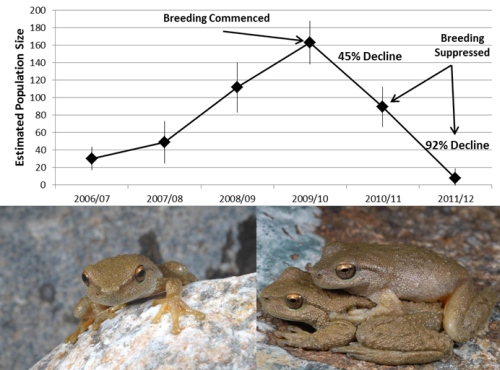
David spoke about translocating Spotted Tree Frogs to another site at Mount Kosciuszko. which could be a potential refuge and free of the two main threats, Chytrid Fungus and Trout. The new site at Deep Creek also has a warmer aspect which may reduce the incidence of Chytrid Fungus. The new site has been used for couple of years and results to-date are encouraging with a new population established.
Long term management perspective
David spoke about the significant length of time required to run these types of programs. These programs require long term recurrent funding sometimes over decades. It is also about developing the right partnerships to help support captive breeding, research and monitoring as well as on-ground management.
More information about the translocation proposal:
http://www.amphibianark.org/pdf/Amphibian-reintroduction-proposal-KNP-2013.pdf
Concepts and examples from the Kosciuszko threatened frogs program are in:
Scheele, B, Hunter, D, Grogan, L et al. (2014) Interventions for Reducing Extinction Risk in Chytridiomycosis-Threatened Amphibians, Conservation Biology, vol. 28, no. 5, pp. 1195-1205
Key points from questions
Reintroduction of the Spotted Tree Frog at Mt Buffalo in Victoria had a similar population trajectory - steadily rising then falling due to an outbreak of Chytrid Fungus.
Both the Spotted Tree Frog and the Corroboree Frog are highly susceptible to infection and have not developed a resistance to the pathogen unlike some other frog species which have evolved to survive Chytrid Fungus.
The potential to apply genetic engineering to develop Chytrid resistant frogs is possible but there is large economic cost which is not supported at present.
Chytrid Fungus has the capacity to infect all amphibian species therefore it could be assumed that any species of frog could be the carrier. It just so happens that at Kosciuszko the Common Eastern Froglet is the host.
Chytrid Fungus is not found in areas where salinity is above 1500 EC. Research from the UK also found a chemical which suppressed Chytrid Fungus but spraying chemicals to combat Chytrid Fungus in the natural environment would be an ineffective long term measure.
Maintaining captive populations for years requires integrating a selection of frogs that are known to survive from eggs to sexual maturity and actively breeding into the population.
Regent Honeyeater supplementation - Dean Ingwersen, Birdlife Australia, Threatened Bird Program Manager, National Regent Honeyeater recovery coordinator.
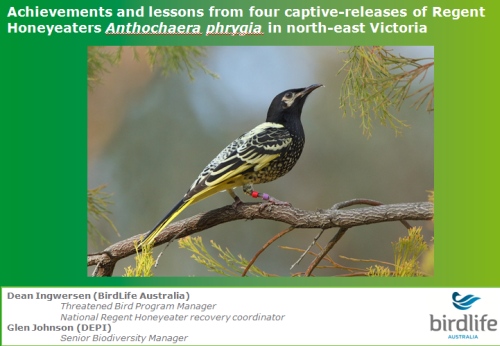
Dean spoke on behalf of project partner Glen Johnson (DELWP), Senior Biodiversity Manager, Wodonga.
Overview
The Regent Honeyeater is a medium-sized honeyeater of temperate woodlands of south-east Australia. In the late 1800's early 1900's it occurred in the thousands but the population now is only about 500. It is listed as Critically Endangered in all states across its range. A formal recovery effort commenced in 1995.
National Recovery Plan Strategies
- Improve the extent and quality of Regent Honeyeater habitat.
- Bolster the wild population with captive-bred birds until the wild population becomes self-sustaining.
- Increase understanding of the size, structure and population trends of the wild population of Regent Honeyeaters.
- Maintain and increase community awareness, understanding and involvement in the recovery program.
Captive breeding
The captive breeding program commenced in 1995 when the wild population was estimated to be around 1,500 -2,000 birds. The program is coordinated by Taronga Zoo but also involves other Zoos as a safe guard. Adelaide Zoo, Cleland Wildlife Park, Melbourne Zoo, Healesville Sanctuary, Australian Reptile Park, Western Plains Zoo, Currumbin Sanctuary and Australia Zoo form part of the captive breeding effort.
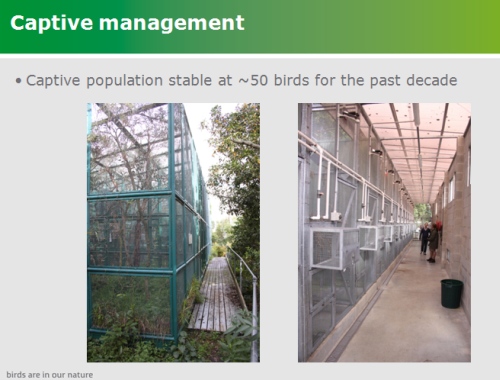
Over the last 10 years the captive population has remained stable at around 50 birds but can reach 140 birds in the lead up to a release.
Genetics
Dean spoke about genetic studies from birds captured between 1989-2012 and birds captured between 2010 and 2013 which were collected from NSW, ACT and Victoria. In summary there is no genetic population structure across the Regent Honeyeater range nor is there any difference between wild and captive bred birds.
Disease risk assessment
Dean spoke about recommendations developed by the recovery team which have been written up in a report 'Regent Honeyeater Disease Risk Analysis, February 2015'. Key recommendations;
- A long-term plan to place all Regent Honeyeaters in the release program in permanent quarantine, separate from exotic birds.
- Place increased resources into health surveillance of the free-living population of Regent Honeyeaters and monitoring the cause of morbidity and mortality.
- Complete disease risk analyses for all the hazards identified in Table 2 to provide a comprehensive evidence-basis for all risk management decisions.
Captive releases
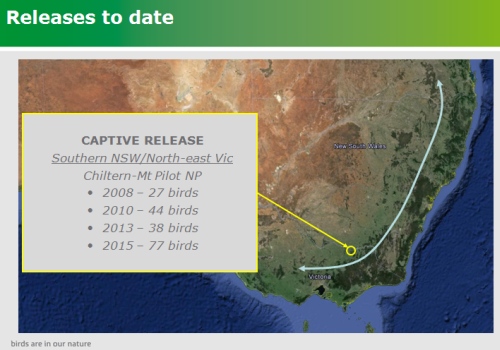
The focus of releases has been in the southern end of the range (blue line) where the population decline has been greatest.
Volunteers
Dean stressed the importance of volunteers in undertaking the monitoring of releases. Without volunteers the program could not go ahead. Roughly 150 volunteers contribute >$150,000 worth of labour per release.
Monitoring
Birds are monitored using colour-band reading and radio tracking using 1.5g transmitters fitted to a proportion of the released birds. Transmitters work for about 12 weeks. Recapture assessment of birds with transmitters found no weight change or loss of fitness.
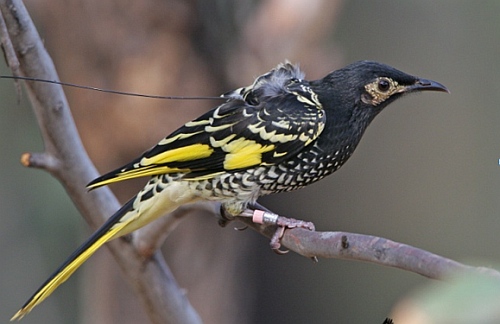
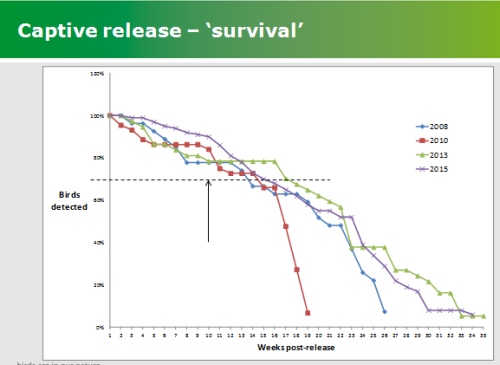
In order to measure the success of each release a target of 70% survival after 10 weeks post release used. Each of the four previous releases has achieved this target. Beyond 10 weeks post release the number of detections drops down but this does indicate the birds have died. Detections become more difficult as birds disperse.
Post release monitoring highlights
Dean provided an overview of highlights from the 2008, 2010, 2013 and 2015 post release monitoring.
The fist release of captive birds in 2008 comprised a variety of age classes, male and female birds with the release split over two dates. Results were positive with all birds surviving and some evidence of integration with the wild population.
Subsequent releases confirmed integration with the wild population and attempted nesting of released birds, even successful breeding between a captive female and wild male in 2011. A successful post release breeding was recorded in 2013 and further post release breeding from the 2015 release.
Compiling data from the 4 years of releases has found 13.8% of released birds being seen 1 year after release which is higher than wild banded birds at around 11%.
Released birds readily disperse across the landscape, one bird was recorded 100 km away.
2015 monitoring results and study nest failures
The largest release of 77 birds was carried out in 2015 but as in previous years there was a high level of nest failure. 22 out of the 26 nesting attempts failed in 2015. A PhD project was set up to determine why nest failures were occurring. A large scale 24 hour video monitoring program was set up which found nest failures were associated with predation of adult birds, eggs, chicks and interference to nests. 20 nest failures were monitored; predation x1, chicks dead in nest x 4 and 15 nests abandoned for unknown reasons. A Sugar Glider and a Squirrel Glider were observed attempting to catch a sitting Regent Honeyeater. A Magpie and a House Sparrow were observed interfering with nests.
Sightings of ex-captive birds
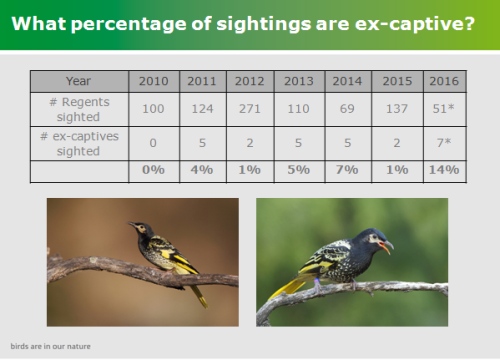
Dean discussed the yearly sighting records and the percentage of ex-captive birds. In 2016, 14 % of the total Regent Honeyeater sightings were ex-captive birds.
Community engagement
The project team has a strong community engagement presence and works closely with the community, particularly in and around Chiltern National Park. There is also a network of volunteers connected with Landcare and other groups who report on sightings.
Use of various forms of media are used to promote the project and foster partnerships. E.g. Taronga Conservation Society, Department of Environment, Land, Water & Planning - Victoria, Birdlife Australia, NSW Office of Environment & Heritage, Parks Victoria, La Trobe University, University of New England, Caring for Country.
Next phase
Build capacity of captive breeding, possibly with a dedicated facility at the Western Plains Zoo, Dubbo.
Trial other tracking technology such as light weight satellite tracking transmitters.
- Release 75 birds every two years
- 2017 – Chiltern
- 2019 – NSW (sites being evaluated)
- 2021 – NSW (sites being evaluated)
Future releases in NSW reflects the status of bird and knowledge that supplementation of captive bred birds can be undertaken in suitable habitat anywhere within its range with effect.
Key points from questions
Climate change is thought to be a major factor in the decline of Regent Honeyeater numbers. Regent Honeyeaters are heavily reliant on good seasonal rainfall resulting in productive flowering seasons which produce nectar.
Noisy Minors compete with Regent Honeyeaters in what is now a depleted environment as the natural landscape has changed due to clearing.
The captive breeding program is limited by space. The majority of released birds are less than 1 year old. It has been difficult to hold older birds that are experienced nest builders and breeders prior to release.
Predation from Sparrowhawks has been observed, particularly in cases where the Regents roost in clusters after release.
Updates on the Regent Honeyeater project
Threatened orchid supplementation - Dr. Nouska Reiter, Botanist, Orchid Conservation Royal Botanic Gardens, Cranbourne, Victoria.
Noushka said orchid reintroduction and supplementation started about 35 years ago. There are now over 13 organisations involved which spans work in Victoria, South Australia and New South Wales.
Between 20 and 30 percent of the known plant species on Earth are predicted to be threatened with extinction (Anderson et al. 2016; Pimm et al. 2014).
Nouska said there are 400 species of orchids in Victoria with about 15% of all plants listed under the EPBC Act being orchids.
Without habitat rehabilitation, research on the ecology of pollinators and mycorrhiza, supplementations and re-introductions it is likely a significant proportion of our orchids will be lost.
Orchids have become threatened because they are easily impacted upon by changes to other components in their environment. Orchids are highly reliant on complex and sometimes specific interrelationships with mycorrhizal fungi, pollinators and even a species of beetle.
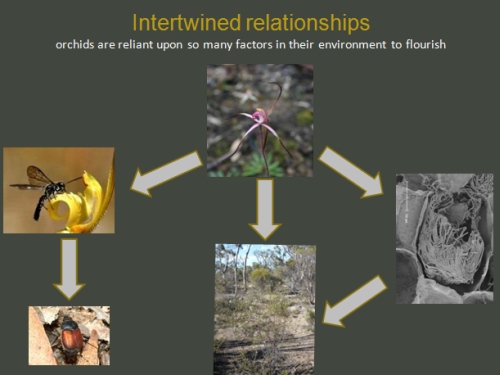
Re-introduction process
Nouska explained the process leading to re-introduction which starts with surveying the existing extent of a selected species population. There are about 80 species of orchids intended for re-introduction with about 30 species underway at present.
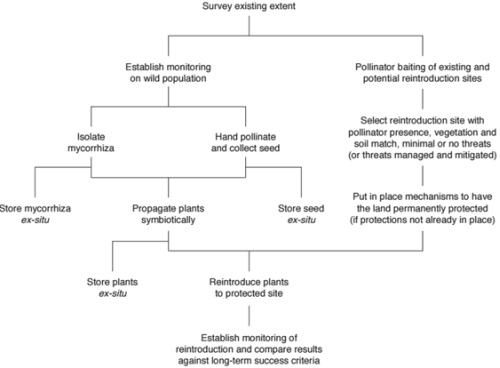
The two main components of re-introduction are;
- Ex-situ pollination and propagation in the laboratory.
- Field management to determine the presence of pollinators and if suitable mycorrhiza are present before any re-introduction can proceed.
Key considerations of re-introductions;
- Threats mitigated
- Land tenure secure
- Land a suitable size for plant and pollinator
- Mycorrhiza and pollinator present
- Diversity of seed (parents)
- Vegetation/habitat match
Further information: Reiter, N et al. (2016). Orchid re-introductions: an evaluation of success and ecological considerations using key comparative studies from Australia. Plant Ecology, 1-15.
Fungal isolations
Nouska spoke about the collection of mycorrhizal fungi which is carried out in winter by digging around the root system of the selected orchid species. The samples are taken back to the laboratory to isolate the mycorrhizal fungi which are grown out. Some species of orchid e.g. Metallic Sun Orchid have their own Mycorrhizal diversity which varies between populations.
Fresh samples are taken each year to prevent any mutations. It also helps to increase the genetic diversity of the mycorrhiza.
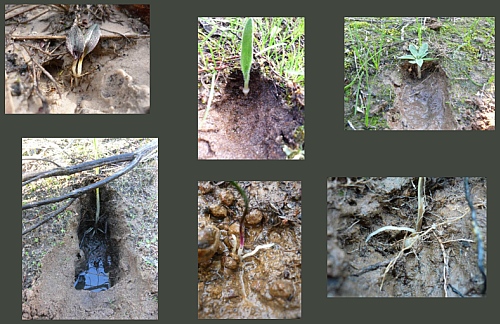
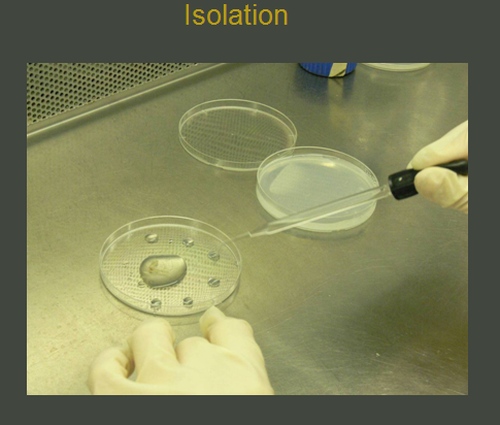
Mycorrhizal fungi is isolated and grown out to be used in the reproductive process.
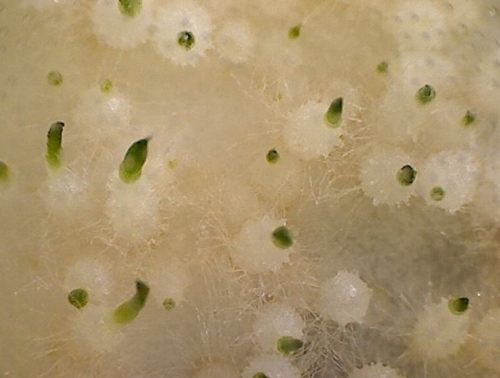
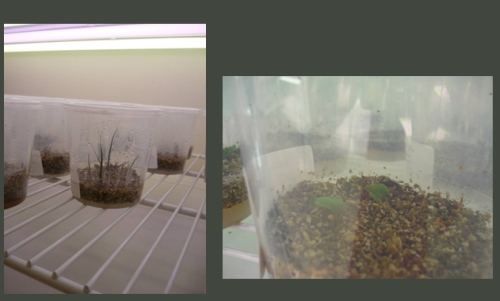
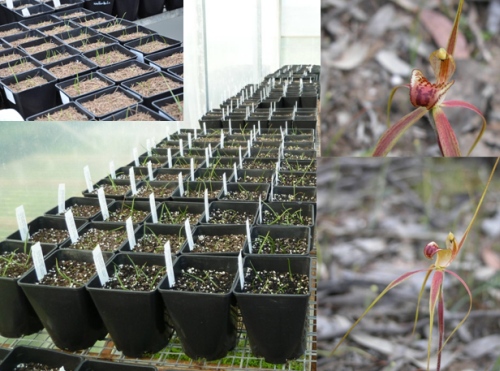
Examples of re-introductions
Candy Spider-orchid Caladenia versicolor - Studies have shown its primary pollinator to be Leoproctus (male bees). Where the pollinator was present at one of the the re-introduction sites there was a significant natural pollination last year on the re-introductions. 310 plants were re-introduced at a site in 2015 of which 74 flowered and of that 40% pollinated. More details; Reiter and Phillips 2016 in prep.
Noushka also spoke about the importance of maintaining the genetics of a population in re-introductions to maintain seed viability.
Re-introduction success
Noushka spoke about re-introduction success at 20 sites between 2007 - 2015. The Victorian re-introductions had 80% flowered, 70% set seed, 20% recruited which higher than the global average of 48% flowering and 25% seed set. The main reasons for improved success is that the re-introduction process takes the mycorrhiza and pollinator into account.
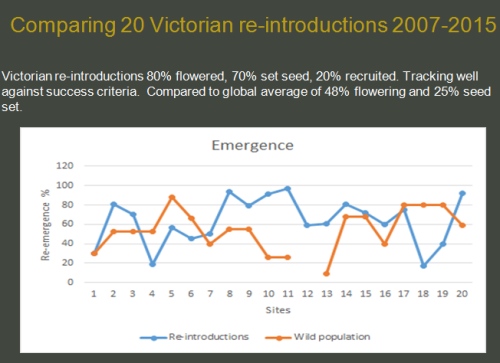
Success criteria are further explained in; Reiter, N., Whitfield, J., Pollard, G., Bedggood, W., Argall, M., Dixon, K., ... & Swarts, N. (2016). Orchid re-introductions: an evaluation of success and ecological considerations using key comparative studies from Australia. Plant Ecology, 1-15
Nouska feels we are now at a stage where for a large proportion of orchid species re-introductions are proven, cost effective and scalable being able to produce hundreds of orchids at a time.
There are still knowledge gaps in relation to mycorrhizal associations and pollinator associations.
One of the key difficulties to overcome is the short term funding cycles for long term projects.
Noushka acknowledged the dedication and collaboration of people and organisations from different fields with complementary knowledge and resources.
Key points from questions
Under the current policy re-introductions are not permitted outside the existing range of a species but with the climate change posing a threat it may be necessary to look at this issue into the future.
Threatened Mammal (Mountain Pygmy-possum) supplementation - Dr. Andrew Weeks, Director CESAR Australia
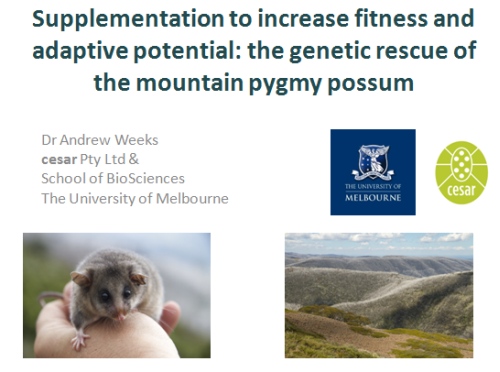
Andrew spoke about how supplementation of threatened species in the wild can be used to maintain or increase population size to assist management of a declining or recovering population. Supplementation can also increase specific demographic groups and provide connectivity across the metapopulation.
Supplementation can also play a valuable role in increasing genetic diversity / fitness in a population.
Genetic diversity
Andrew provided an insight into the influences genetic diversity can have on species extinction. He said fragmentation of populations reduces gene flow which leads to small population size and process of random genetic drift resulting in reductions in genetic diversity.
He said many threatened species suffer from genetic distinctiveness and have maladapted populations.
Evolutionary rates are influenced by;
- Population size (big = faster, mutation)
- Movement of genes between populations
- Movement of genes between species
Andrew said connectivity is critical in the evolutionary process and lack of connectivity often being a factor relating to threatened species.
Supplementation for genetic reasons
- Genetic rescue (short term) - Restoring the fitness of a population through the removal of slightly deleterious alleles
- Genetic restoration (long term) - Restoring the adaptive capacity of a population
- Gene pool mixing (short & long term) - Combination of the above, through mixing of divergent genomes
Genetic rescue: Mountain Pygmy Possum
Andrew provided a brief overview of the issues facing the Mountain Pygmy Possum which has a population of less than 2000. It is listed as endangered under the EPBC Act and the IUCN Red List. The possum is restricted to the alpine/sub-alpine zone of Australia and only found at three isolated geographic regions (Mt Buller, Bogong Highplains and northern regions of Mount Kosciuszko). The possum's prime habitat occurs in ski resort areas where it hibernates amongst boulders under a cover of snow.
Andrew said studies found there was a high genetic variation between the Southern, Central and Northern populations i.e. 3 distinct evolutionary significant units.
Decline at Mt Buller
Andrew spoke about the significant decline in the Mt Buller population. Surveys have been conducted at Mt Buller during the spring on a regular basis since 1997. David pointed out the very low numbers of males in the population.
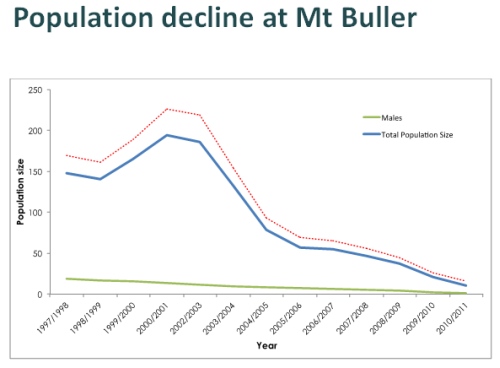
Threats
Ski field development has expanded quite considerably since the 1970's with an incremental loss of Mountain Pygmy Possum habitat.
Bushfires have also burnt areas of Mountain Pygmy Possum habitat.
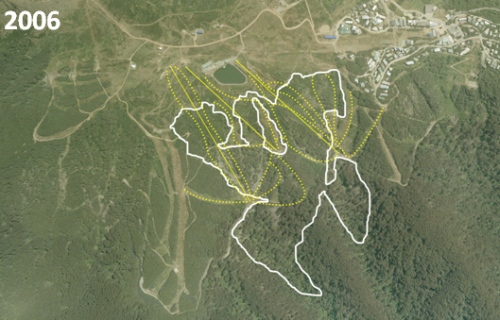
The white line indicates Mountain Pygmy Possum habitat at Mt Buller, the solid yellow lines are ski lifts and the yellow dotted line ski runs.
Habitat management
In 2006 a recovery plan was put in place by the Mt Buller Management Board which resulted in a number of habitat management projects such as artificial boulderfields to link habitats. Predator control programs are undertaken seasonally and all ski resort developments must meet environmental standards for the protection of Mountain Pygmy Possum habitat.
Supplementation: genetic rescue
Due to the continuing decline of the Mt Buller population coupled with studies which revealed an on-going genetic decline at Mt Buller compared with Mt Hotham a genetic rescue plan was implemented.
Wild translocations of 6 male Mountain Pygmy Possums from Mt Hotham were carried out in October 2010, and again in September 2011. These wild male translocations were effective in increasing the genetic flow with 2 hybrids detected in 2010 and 50% juvenile hybrids in 2011. There has also been an increase in F1 hybrids with more pouch young and F2 females all had 4 pouch young (which is the first time this has been observed).
In 2015, 87% of the population now have some central genes.
Based on a translocation plan (Weeks & Corrigan 2011) further translocations were carried out in 2014, with 6 males from the central region to increase diversity.
Andrew spoke about the measured increase in genetic diversity of the Mt Buller population since wild translocations commenced. He also pointed out the end result of their work was to increase the population size which is now on the rise.
%20%20population%20increase%20graph.jpg)
Red arrows indicate genetic rescue translocations of male Mountain Pygmy Possums.
Summary
Pros
- all three translocations achieved there aims
- increased fitness, population size and genetic diversity
- no removal of animals from the wild
- very low cost compared with captive breeding
Cons
- on mountain issues critical for success e.g. habitat connectivity
- timing of translocations critical
- biology of species critical
- approval process difficult
Future work
Wild translocations between habitat patches at Mt Buller to increase population size.
Andrew acknowledged the tremendous effort from partners in the project, in particular'
- Dean Heinze (Wildlife Ecologist)
- Lou Perrin (Mt Buller Resort Management)
- Ian Mansergh (formerly DSE)
- Anthony van Rooyen (cesar)
- Tom Kelly (cesar & Mt Buller Resort Management)
- Jerry Alexander (DELWP)
- DELWP
- Mt Hotham Resort Management
Reference
Weeks, A.R., Corrigan, T., 2011. Translocation strategy for the Mount Buller population of the mountain pygmy possum. Victorian Government Department of Sustainability and Environment (DSE), Melbourne.
Key points from questions
Approvals for translocations of wild Mountain Pygmy Possums were possible because of the considerable amount of biological information that had been gathered through research over the years.
The expansion of the Mt Buller population to other nearby known habitat could be retarded due to a number of factors; habitat quality may not have recovered from 206 fires, physical distance of 5-6 km across the summit and predation. If a functioning population was to be establish in a new area on Mt Buller the most effective means would be to relocate some individuals.
The successful genetic rescue of Mountain Pygmy Possums at Mt Buller has paved the way for re-thinking methods of supplementation and building evolutionary resilience particularly in cases where threats are well understood and why populations have decreased.
Establishing new Mountain Pygmy Possum populations on prime habitat beyond the three main areas is not considered in the current recovery plan but something that could be looked at into the future.
General discussion
There is a view that we may need to be more responsive and less cautious about managing relocations of certain threatened species in the face of climate change as we may not have the time to gather all the data which was required in the past.
Taking risks can only be of value if we learn from what we do.
High fees associated with gaining Animal Ethics Committee approval can stifle citizen science initiatives.
KEY POINT SUMMARY
| Captive breeding and reintroduction has effectively averted the complete extinction of the Southern Corroboree Frog in the wild. |
| The main reason for decline of the Southern Corroboree Frog and Spotted Tree Frog is infection by the Amphibian Chytrid Fungus (Batrachochytrium dendrobatidis) which is thought to have arrived in Australia in the early 1970's. |
| The Regent Honeyeater once once occurred in the thousands but only about 500 remain in the wild. |
| In 2016, 14 % of the total Regent Honeyeater sightings were ex-captive birds. |
| Without habitat rehabilitation, research on the ecology of pollinators and mycorrhiza, supplementations and re-introductions it is likely a significant proportion of our orchids will be lost. |
| Connectivity is critical in the evolutionary process with lack of connectivity often being a factor relating to threatened species. |
| Threatened species can be saved through supplementation in the form of innovative reintroduction to reduce threats, genetic rescue and captive breeding for reintroduction into the wild. |
| Our community can play a vital role in monitoring and supporting supplementation projects. |


